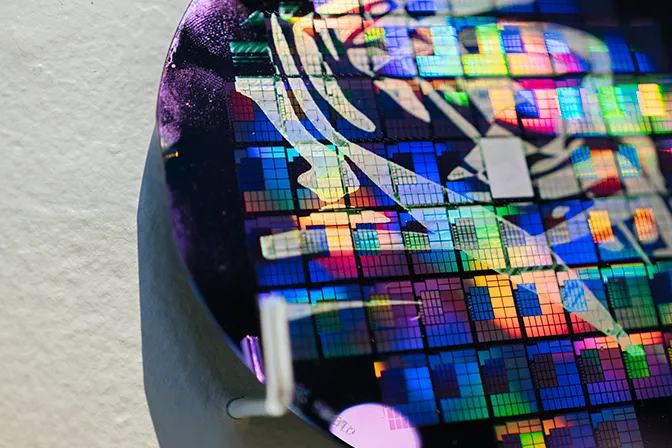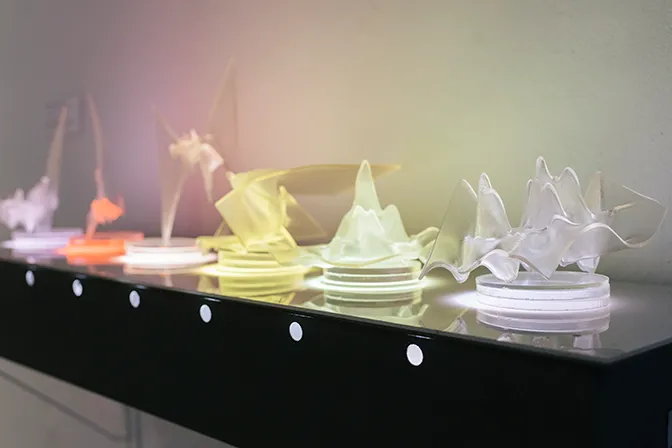For centuries, artists have broken the boundaries of the possible by pushing their tools and media to their breaking points. Jenn Karson, a lecturer in the Department of Art and Art History and the director of UVM’s FabLab, continued that trend of breaking norms and dismantling dichotomies with her recent show, Liquid Architectures + Leaky Territories, an exploration at the crossroads between art and artificial intelligence. Utilizing UVM’s Vermont Advanced Computing Center (VACC), Karson used vast amounts of data and various machine learning processes to produce multidimensional artwork that, according to the artist statement, “challenge traditional concepts of artistic authorship and human-machine collaboration.”
“The show is based on two years of research that engaged undergraduate and graduate students here at UVM as well as other faculty and staff, and we initially set out to explore opportunities to create artworks using the tools available to us in the VACC service,” Karson said. “The research went into a number of different directions, but what this exhibition really brought together was a lot of decisions and to show the most interesting discoveries.”
The artwork itself spans across different media: physical prints, film slides illuminated by an old Kodak projector, digital animations, three-dimensional stereolithographic sculptures, and etched silicon wafers.
“We were generating images using different kinds of machine learning. These images were digital files, which meant that they were more than just images. They were actually digital [and] numerical information,” Karson said. “And with that information, we started really exploring this idea of multidimensional space, the mathematical space that helped generate the images. We sought out to represent that multidimensional space using different kinds of digital and analog tools.”
The prints, which are outputs of machine learning, represent thousands of steps from artistically reassembling basic building blocks, resulting in an image that is simultaneously organic and digital. Each print features two prominent checkboxes labeled “real” and “fake.” Both are checked on every print, referencing the cycle of analog-to-digital artworks and the human-machine collaboration.

“We were playing off of something that's automated within the machine learning we were using,” Karson said. “Whatever data we put in was considered a ‘real’, and the data that came out of it was considered a ‘fake.’ The files were named that automatically, it wasn't even a choice of ours.”
Viewed closely, the prints show digital artifacts and noise. Usually considered a nuisance in digital artwork, Karson believed the noise was a part of the artwork.
“If this had all gone perfectly, everything communicating properly, [the prints] would be smooth, Karson said. “That's essentially a distortion through breaking the program, which is what artists have always done with technology, pushing it in ways it's not meant to go.”
Another element of distortion within the exhibit was a projection of animated artworks onto a scrim accompanied by sounds echoing off the exhibit walls and throughout Williams Hall.
“I was so drawn to these animations, a tool available through [the machine learning]. They're called latent space walks,” Karson said. “The multidimensionality of these images is very much the same thing that drew me to working with sound. When you project sound in a space like [Williams], it can sound different depending on where you are in the space. Sound travels in an unexpected and multidimensional way. You can think of it like wind or any kind of air flow. It's always moving. When these images were coming up, and I considered how to share them, I realized the approach to sound I had been taking all these years was similar.”
Karson even took the artwork into a higher dimension, utilizing stereolithographic 3D printing to form a kind of topographic map for each print.

“Each one of these sculptures is based on one of the images. I took an image and turned it into a line drawing,” Karson said. “It's just based on the contours, and I took those contours into a 3D modelling program and created a topography within them. I made decisions about what would be high or low. It was related to the idea of exploring a multidimensional space. You're seeing them in 2D here, in transition [on the silicon wafers], and now you're seeing in a 3D topography.”
The exhibit allowed students, alum, faculty, and staff to answer questions about the complexities of digital art and the dichotomies between real and fake.
“The opportunity that we had, I can't imagine it existing anywhere else,” Karson said. “This is the result of a community of people at UVM supporting us.”
